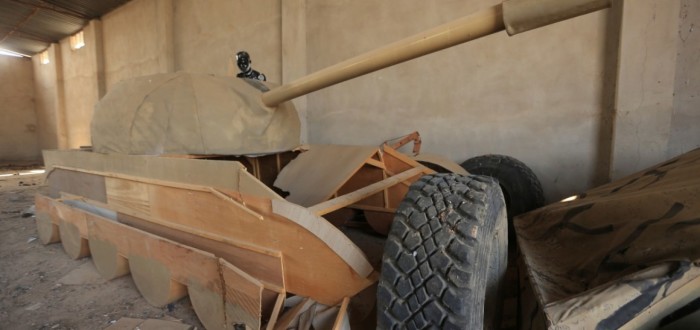Paul Mutter
Tricks such as strapping mannequins onto spare horses and lighting extra camp fires have been used for centuries to deceive reconnaissance, especially by smaller or more technologically-limited forces. Both Axis and Allied forces made extensive use of decoys during the Second World War. However, modern forces have also seen the benefit of decoy tactics in other modern conflicts. In the first Gulf War, ADM-141 Tactical Air Launched Decoys were launched to spam Iraqi radar sites, and the balloon manufacturer RUSBAL has been pitching its inflatable models to the Russian armed forces, promising that these can mimic “visual, temperature and radio characteristics”. A wide variety of similar examples can be found.
In the same vein, the so-called Islamic State (IS) has employed a range of decoys in an effort to limit the Coalition’s air power advantage. Wooden mock-ups of HMWWV light tactical vehicles, main battle tanks, and other platforms were recently discovered by the Iraqi Army in Islamic State workshops in northern Mosul. Additionally, in the course of the Battle of Manbij from June-August 2016, the opposition Syrian Democratic Forces (SDF) uncovered a factory that had been used by IS to build fake weapons in an effort to fool aerial reconnaissance. Below the embedded video is a Kurdish-to-English transcription provided to ARES:
[00:00-00:06] As we see these are fake weapons, they are just a piece of metal.
[00:07-0014] How and why ISIS fighters were using these [fake] weapons in the battle of Manbij? And how did you find these weapons?
[00:15-00:39] After capturing Manbij we got informed through interrogation of one of the sleeper cells’ members inside the city of Manbij that there is a warehouse of weapons, after that we went to the location.
[00:40-01:12] The weapons are some DShKs and mortars. These were used to put fear among people, and put to mislead coalition airstrikes. That is why we came to the location and captured them.
[01:13-01:17] These fake weapons that are made of metal only, did you capture these only in the city of Manbij or elsewhere?
[01:18-01:33] We captured these in three or four positions. There is a palace called Sab’ Bahrat in the city of Manbij, and a warehouse near a road, called the Jarablus Road.
[01:34-01:45] And there was another location, which there were warehouses under the ground. Based on the intelligence we got, we went there and captured these.
[01:46-02:20] This is like [the] DShK, 14.5mm, ISIS used these to fear people and put in some positions and they [ISIS] were not in the position this resulted to mislead the airstrikes and ruining civilian houses that put more fear among people.
There are two identifiable variants of heavy machine gun (HMG) on display. One is modelled on the DShKM (12.7 x 108 mm) HMG and the other modelled after the larger calibre KPV (14.5 x 114 mm) HMG. Variants produced in the former Yugoslavia, Iran, and the People’s Republic of China have routinely been observed in the Syrian conflict. Ammunition is in no short supply for these weapons, and with their ease of use and simple maintenance requirements, these weapons provide ground support and limited anti-aircraft (AA) cover for a wide variety of groups.
Despite their age, the real versions of these HMGs may still pose a threat to modern low-flying fixed wing and rotary aircraft if operated with proper fire control. Senior Master Sergeant Robert L. LaPointe (ret.) describes in his book on U.S. S&R tactics during the Vietnam War that the “Dashka” (DShK and DShKM model HMGs, more often spelled ‘Dushka’) was especially lethal against helicopters. And former Soviet Air Force MiG-29 pilot Alexander Zuyev noted that the mujahedeen’s Chinese-made “12.7 mm and 14.5 mm antiaircraft guns could [still] be dangerous below an altitude of about 4,500 feet” during the Soviet-Afghan War.
Due to the assumption that Coalition forces understand the tactical and strategic importance of these weapons, the rationale for the construction of decoys appears to be an effort to draw airstrikes onto their positions. These decoys could be deliberately placed close to civilian areas in order to terrorise the civilian population under the prospect of attracting Coalition airstrikes. Of added benefit is the increased cost of bombing fake targets increases pressure on coalition forces in terms of expenditure and aircraft flight hours. In addition to distraction, IS has instituted rudimentary measures to conceal its movement as it operates against Coalition forces with air superiority.
Transcript provided by MI Rasool.
Remember, all arms and munitions are dangerous. Treat all firearms as if they are loaded, and all munitions as if they are live, until you have personally confirmed otherwise. If you do not have specialist knowledge, never assume that arms or munitions are safe to handle until they have been inspected by a subject matter specialist. You should not approach, handle, move, operate, or modify arms and munitions unless explicitly trained to do so. If you encounter any unexploded ordnance (UXO) or explosive remnants of war (ERW), always remember the ‘ARMS’ acronym:
AVOID the area
RECORD all relevant information
MARK the area to warn others
SEEK assistance from the relevant authorities


Pingback: Houthi forces deploy decoys to counter Coalition airpower – Armament Research Services